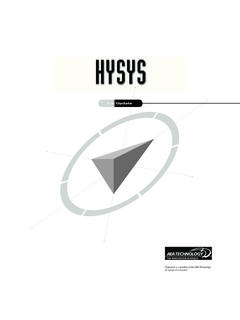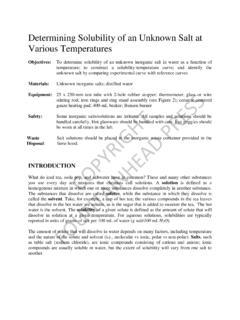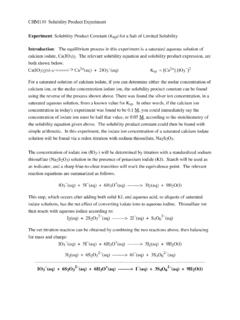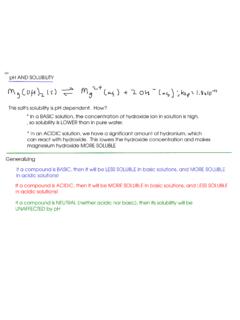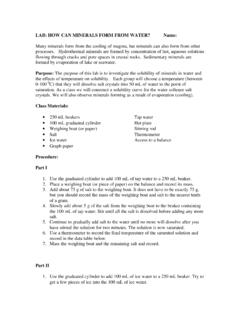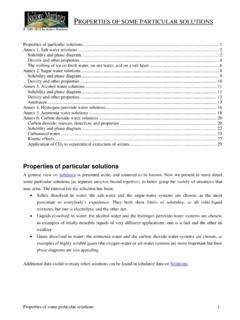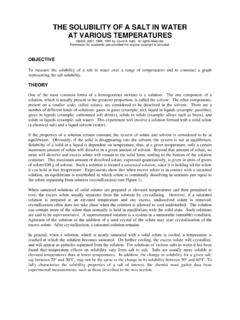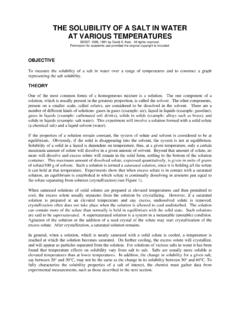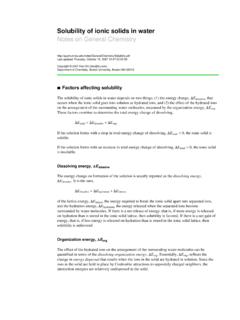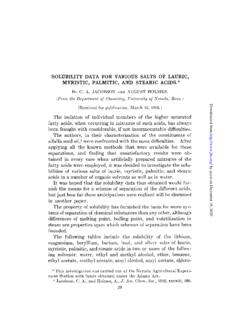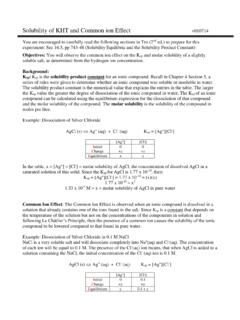Transcription of SOLUBILITY AND SOLUBILITY PRODUCT - Instruct
1 142 SOLUBILITY AND SOLUBILITY PRODUCT [MH 5; & ] In this section we are going to consider the SOLUBILITY of ionic solidsin water. SOLUBILITY may be considered to be an equilibrium; the equilibriumis between solid and ions in solution. Any ionic solid is 100% ionized in aqueous solution; once it actuallydissolves. The term SOLUBILITY always refers to the amount of solid (either inmoles or grams) that actually does dissolve in solution, producingions; this amount can be calculated for a particular solid. The term SOLUBILITY may also be used in a qualitative sense; there isno magic point above which a salt can be described as soluble , andbelow which a salt can be described as insoluble .Very Soluble - at least mol L 1 dissolves Slightly Soluble - maybe to mol L 1 Insoluble - less than mol L 1 EXAMPLE 1:Bi2S3(s) 2 Bi3+(aq) + 3 S2 (aq)What is the form of the equilibrium constant for this particularequilibrium?
2 143 EXAMPLE 2:For a solution of AgCR in water, the equilibrium is:AgCR(s) Ag+(aq) + CR (aq) When the equilibrium is set up all three components must bepresent, to be sure that the system is at equilibrium. The equilibrium constant K = We call this type of K a SOLUBILITY PRODUCT Constant, symbolized byKsp. So, Ksp(AgCR) is the SOLUBILITY PRODUCT constant for AgCR, when itdissolves (or tries to!) according to the above equation. Like most Keq s, its value depends on T; this is why more solid usuallydissolves in a solution at a higher Using KspEXAMPLE 1: Calculate the SOLUBILITY , in mol L 1, of AgCR(s). [Ksp (AgCR) = 10 10] 144 EXAMPLE 2:Calcium carbonate, CaCO3, has a SOLUBILITY in water of g L 1at 25 EC. Calculate the Ksp for CaCO3. [MM of CaCO3 = g mol 1] 145 EXAMPLE 3:Calcium fluoride, CaF2, dissolves in water to the extent of g per 100 mL. What is the Ksp for (CaF2) ?
3 [MM CaF2 = g mol 1] 146 EXAMPLE 4:If solid PbCR2 equilibrates with pure water, what are [Pb2+] and [CR ] inthe solution at equilibrium? [Ksp(PbCR2) = 10 5] 147 SOLUBILITY and the Common Ion Effect The Common Ion Effect is an illustration of Le Chatelier sPrinciple. Consider the equilibrium:AgCR(s) Ag+(aq) + CR (aq) What happens to the position of equilibrium if we add some extrachloride ion, CR (or silver ion, Ag+)? What does this mean, qualitatively, for the SOLUBILITY of AgCR ifthere is already Ag+ or CR in the solution? 148 EXAMPLE 1:Solid AgCR (Ksp = 10 10) is equilibrated with M NaCR solution. a) How many moles of AgCR will dissolve in L of the NaCR solution ? b) What is the SOLUBILITY of AgCR in the NaCR solution ? SOLUBILITY of AgCR in pure water = 10 5 M (p. 143).In the NaCR solution: only % of the SOLUBILITY in water alone! 149 EXAMPLE 2:What is the concentration of Ca2+ (aq) in molL 1, in a solution made byequilibrating CaF2(s) with M KF solution?
4 [Ksp for CaF2 = 10 11] (Compare this answer with p. 145) 150 EXAMPLE 3:Calculate the SOLUBILITY of PbCR2, in molL 1, in a solution of M MgCR2. [Ksp for PbCR2 is x 10 5] 151 Saturated and Unsaturated Solutions The term saturated implies that there is equilibrium betweensolid and solution. If the quantity of a substance in solution is less than that requiredfor equilibrium with the solid, the solution is said to be unsaturated . This is a common, stable, situation but it is not an equilibrium (so Kspdoesn t apply). If more solid as added to an unsaturated solution, it dissolves untilthe solution is saturated (at which point there is solid in equilibriumwith the solvated ions). Consider the compound A2B; first we dissolve some in water toproduce a saturated solution. We could write an expression for Q, the Reaction Quotient (p. 139): For a saturated solution, Q = Ksp . Now suppose that we mix two solutions containing the ions A+(aq)and B2 (aq).
5 The sparingly soluble compound A2B may be formed. Write an expression for Q; we call this the Ion PRODUCT : We will assume that precipitation will occur at the point where Q $ Ksp. If Q < Ksp, the solution is unsaturated and no precipitation willoccur. It is also possible for Q > Ksp, usually briefly. 152 This is a non-equilibrium situation for a solution that issupersaturated, has ion concentrations greater than equilibriumvalues. We can determine the actual concentrations of one of the ionsinvolved in the formation of a precipitate by setting the Ion Productequal to 1:How much solid Pb(NO3)2 must be added to L of M Na2SO4solution for a precipitate of PbSO4 , [Ksp = 10 8] to form ? Assume no change in volume when the solid is added. 153 EXAMPLE 2:PbCR2 has Ksp = 10 5. If equal volumes of M Pb(NO3)2 M KCR are mixed, will precipitation occur?(Remember that dilution will occur: If equal volumes are mixed, theconcentration of each solute is halved.)
6 154 EXAMPLE 3:An experiment is performed in which 100 mL of M Ca(NO3)2 aremixed with 200 mL of M NaF.[Ksp for CaF2 = x 10 11]i) Will precipitation occur?ii) What is the concentration of F in the solution when the reaction iscomplete? 155 We can also determine the Ksp of a compound experimentally, bycarefully measuring the amounts of solutions needed to precipitatethe compound in question. Take a sample of a solution that contains one of the ions in thecompound. That sample must be of known volume and molarity. To this solution, carefully add a second solution which contains theother ion present in the compound. The molarity of this secondsolution must also be known. As soon as precipitation of the compound begins to occur, thevolume of the second solution is measured. The molarities of both ions in the compound are now determined andan Ion PRODUCT is calculated. This Ion PRODUCT must be equal to : When mL of a M KF solution is added to mL of M solution of Ba(NO3)2, the first trace of a precipitate of BaF2is seen.
7 What is the Ksp for BaF2 ? 156 Selective Precipitation Problems [MH5; page 430] Where there is a possibility for two salts to precipitate, the lesssoluble will precipitate :CaSO4 has Ksp = 10 5 and SrSO4 has a Ksp of 10 7. (SoSrSO4 is less soluble.) A solution has a concentration of M of both Ca2+ and Sr2+ ; then Na2SO4(s) is slowly added. What is the [SO42!] at the point where precipitation starts? SrSO4 has the lower Ksp and will precipitate first, when: As further Na2SO4 is added, the [SO42 ] increases and SrSO4continues to precipitate. Precipitation decreases the [Sr2+], so a steady increase in [SO42 ] isnecessary for the ion PRODUCT of SrSO4 to be exceeded[Sr2+][SO42 ][Sr2+][SO42 ] 10 6 10 10 10 10 4 157 Eventually the [SO42 ] will be large enough to exceed the ionproduct for CaSO4; it starts to precipitate when the [SO42 ] is: At this point (still saturated in SrSO4) the [Sr2+] will be: As a fraction of the amount originally present,Sr2+ remaining = Nearly 99% of the Sr2+ has precipitated !
8 This effect can be used in Semi-micro Qualitative [MH5; page 436] 158 SOLUBILITY and pH (and Complexation) Problems [MH5; ] The SOLUBILITY of many substances influences, and is influenced by,the pH of the solution. Metal Hydroxides often have low 1: Ca(OH)2 has Ksp = 10 6. What is the pH of a solution made by equilibrating solid Ca(OH)2 withwater? 159 Many metal hydroxides have solubilities so low that their saturatedsolutions are not appreciably 2:Cu(OH)2 has Ksp = 10 19a) What is the pH of a saturated solution of Cu(OH)2 ?b) What is the maximum [Cu2+] concentration possible in a neutralsolution? (pH = 7) 160 c) What is the maximum pH of a solution in which [Cu2+] = M ? What conclusion can we draw from this calculation? The solubilities of salts of weak acids are very much affected bythe pH of the solution; to be discussed qualitatively only. 161 EXAMPLE:AgCR and AgBr are not appreciably soluble.
9 When HNO3 is added,nothing happens. CH3 COOAg also has a low SOLUBILITY in water, but dissolves readily ifHNO3 is added. Can we explain this observation qualitatively?Equilibria:AgCR(s) Ag+(aq) + CR (aq)H+ + CR / HCR (strong acid)AgBr(s) Ag+(aq) + Br (aq)H+ + Br / HBr (strong acid) AgAc (s) Ag+(aq) + Ac (aq)H+ (aq) + Ac (aq) HAc (weak acid) 162 Complexation can increase SOLUBILITY The SOLUBILITY of many salts can be increased by the addition of aspecies that can form a complex ion with one of the ions (usually thecation) formed when a poorly soluble salt dissolves. EXAMPLE 1: AgCR (Ksp = x 10 10) dissolves when NH3(aq) or CN (aq) is added:Equilibria:AgCR Ag+(aq) + CR (aq)Ag+(aq) + 2 NH3(aq) [Ag(NH3)2]+(aq)orAg+(aq) + 2 CN (aq) [Ag(CN)2] EXAMPLE 2:Cu(OH)2 ( 10 19) similarly dissolves when NH3 (aq) is added:Equilibria:Cu(OH)2 Cu2+(aq) + 2 OH (aq)Cu2+(aq) + 4 NH3(aq) [Cu(NH3)4]2+


